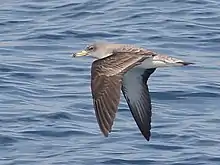Scopoli's shearwater
Scopoli's shearwater (Calonectris diomedea) is a bird in the family Procellariidae currently considered conspecific with Cory's shearwater (Calonectris borealis). It has no subspecies.[2] The genus name Calonectris comes from Ancient Greek kalos, "good" and nectris, "swimmer". The specific diomedea refers to Diomedes, the mythical king. His wife was serially unfaithful while he fought at Troy, so he left to found a city in Italy. After his death, his distraught friends were turned into white seabirds.[3] The English name is for Italian naturalist Giovanni Antonio Scopoli who first described the species.
| Scopoli's shearwater | |
|---|---|
 | |
| Scientific classification | |
| Kingdom: | Animalia |
| Phylum: | Chordata |
| Class: | Aves |
| Order: | Procellariiformes |
| Family: | Procellariidae |
| Genus: | Calonectris |
| Species: | C. diomedea |
| Binomial name | |
| Calonectris diomedea (Scopoli, 1769) | |
 | |

Range

Calonectris diomedea breeds across the Mediterranean; on Menorca, Ibiza, Formentera, Cabrera, Conillera and Dragonera in the Balearics; on the Îles d'Hyères in France; on Elba, small islands off Sardinia and Sicily, Pantelleria and Lampedusa in Italy; In Malta; on coastal Croatian islands and parts of the mainland; on Kythira, Kolpos and the Cyclades in Greece.[4]
The majority of the population spends the non-breeding season in the Atlantic, including areas off the west coast of Africa and east coast of Brazil, as well as on the Greek islands.[5]
Diet
Their diet is mostly squid, which are obtained mainly by surface-seizing. They are regularly attracted to trawlers to feed on offal. Sometimes they defecate on visitors who draw too near to their habitation.[5]
References
- Birdlife International (2014). "Calonectris diomedea". IUCN Red List of Threatened Species. 2014. Retrieved 15 January 2015.CS1 maint: ref=harv (link)
- "Loons, penguins, petrels". International Ornithological Congress. Retrieved 2015-01-15.
- Jobling, James A (2010). The Helm Dictionary of Scientific Bird Names. London: Christopher Helm. pp. 86, 136, 267. ISBN 978-1-4081-2501-4.
- "Calonectris diomedea range map". International Union for Conservation of Nature. Retrieved 2015-01-15.
- "Calonectris diomedea". IUCN Red List of Threatened Species. Retrieved 2015-01-15.
